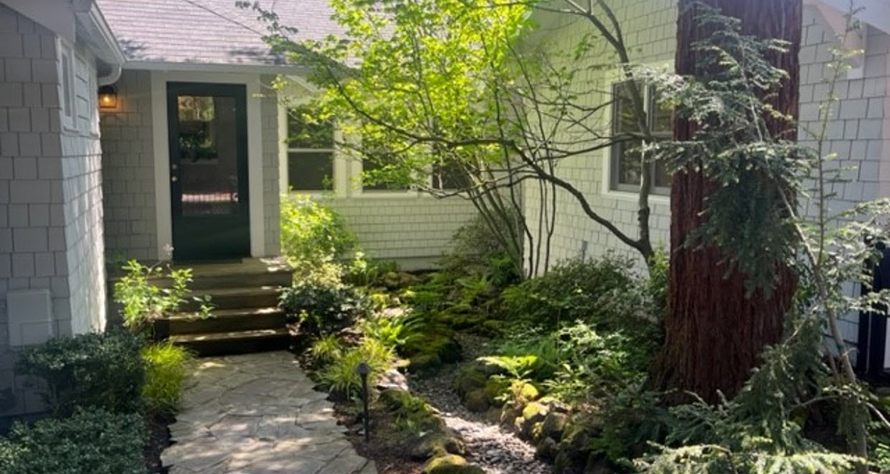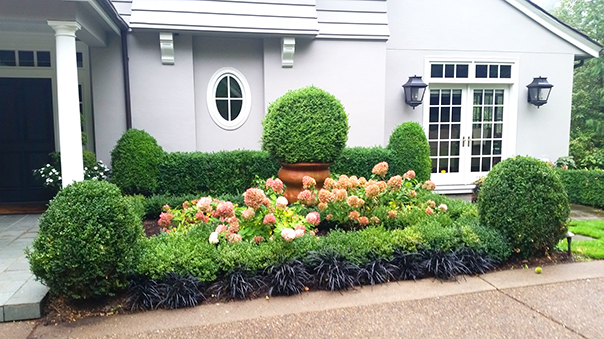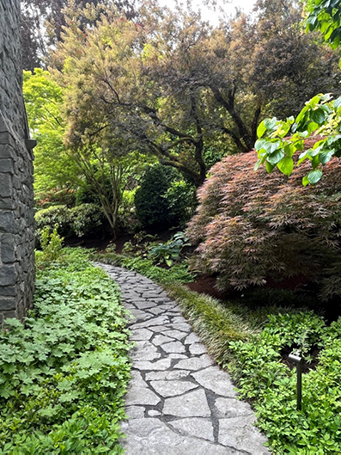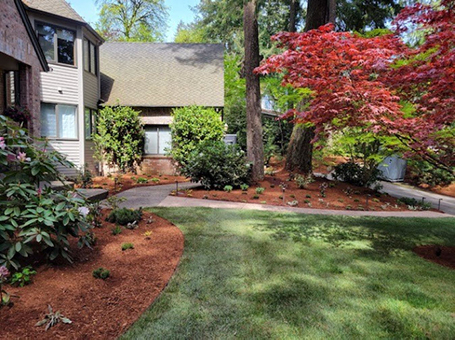Landscape Maintenance for a Beautiful Spring

You may not be ready to start thinking about colder and wetter weather, but now is the time to winterize your plants for the coming months. The Pacific Northwest mostly avoids the harshest winter weather, but to keep your landscape healthy it needs to be protected. Our team at Landscape East & West is already out pruning, thinning, and mulching so our clients’ yards will be ready for the next spring bloom.
Here’s the landscape maintenance we recommend homeowners focus on to keep plants happy and healthy through wind, rain, snow, and ice.
Basic Landscape Maintenance
Plants like azaleas and hollies stay green throughout the winter, so basic landscape maintenance like trimming back branches that are crowding each other and ensuring the plants aren’t being infested by any insects is about all you’ll need to do. If you do find signs of insects, we suggest you chase the pests away by spraying an eco-friendly horticultural oil rather than a toxic pesticide. If you’re not sure whether the signs of damage are from an insect or disease, contact a local garden center or landscape contractor to help you identify the problem and find the correct solution.
Deadhead Old Blooms

The ornamental beds in your yard need attention, which means it’s time to deadhead old blooms. Nothing says end of summer to a Pacific Northwesterner than having to cut off the beautiful blooms from a hydrangea plant. These flowers are so beloved, you can find dried ones adorning homes across the state. It may seem hard to say goodbye but the hydrangea, and all of the other flowering plants that you swiftly cut the dead blooms from, will thank you by coming to life next summer.
Prudent Pruning
 If you’re looking for more instant gratification, we often recommend pruning roses in the late summer to encourage one more round of blooms before temperatures drop. Remove the dead or crossing canes and suckers, and cut back canes to groups of five leaves to promote more blossoms. Or, if you’re ready to embrace the new season, roses can be left alone, deadheads and all, to allow the bush to produce hips and slow down growth for its winter slumber.
If you’re looking for more instant gratification, we often recommend pruning roses in the late summer to encourage one more round of blooms before temperatures drop. Remove the dead or crossing canes and suckers, and cut back canes to groups of five leaves to promote more blossoms. Or, if you’re ready to embrace the new season, roses can be left alone, deadheads and all, to allow the bush to produce hips and slow down growth for its winter slumber.
Roses aren’t the only plants that could use some pruning to keep them healthy. Because you never want to over-prune and leave the plants damaged or weakened, it’s best to talk to a professional. Too often, plants are sheared with electric clippers with no thought as to how too much pruning can impact the flow of nutrients and energy to the plant. Pruning at the wrong time or too vigorously can remove the flower buds that are lying in wait to bloom next spring. Spring-flowering plants like forsythia and rhododendron form spring buds in late summer so now is not the time to prune.
Avoiding excessive pruning of trees and shrubs is also important. However, healthy plants need good circulation to ward off disease. Thinning both deciduous and evergreen trees and shrubs of summer growth not only allows for more air, sun, and water but also improves the appearance. If you want to have well-shaped shrubs, now is the time to prune to your desired shape.
Mulch Matters

With deadheading and pruning complete, next up is to remove weeds and lay down a layer of mulch. Mulch is made of organic material that gives a layer of nutrient-rich humus to your beds. It’s used to protect the bare soil between your plants and to minimize weeds. Mulch can be purchased from landscape supply companies, as well as from local compost and mulch suppliers. But mulch can also be part of your yard’s own recycle and reuse program. Dry leaves, grass clippings, and other detritus that litter your yard can easily serve as mulch. Look at the circular life cycle!
Soil Assessment
And as long as we’re talking soil, a final end-of-summer/pre-fall prep is to assess your soil. Take a sample of your soil to a nearby nursery for testing. The results will provide a better understanding of how to add compost or other natural solutions to improve soil quality.
Soil assessments measure different properties of soil that provide clues as to how healthy the soil is. Most gardeners know that the pH of the soil should be tested, but it can also be measured for density, water, and nutrient retention, as well as what microbes and enzymes might be present. That’s a lot of science speak for things like how quickly water is absorbed or flows through your soil and does it have cool things like earthworms living happily in it. At Landscape East & West, we regularly test our clients’ soil because we know what’s in the ground can subtly change, but that change can have a big impact on your plants. It’s best to know what lies beneath.
We appreciate all you green thumbs who enjoy getting up close and personal with the dirt in your yard, but if you’re not quite sure how much to trim or mulch, or exactly which plants need pruning, we’re happy to step in. Preparing your landscape for winter weather is critical to assuring a beautiful spring, so don’t wait. Contact Landscape East & West today to schedule your yard’s winterization. And check out some more of our fall-winterization tips.
